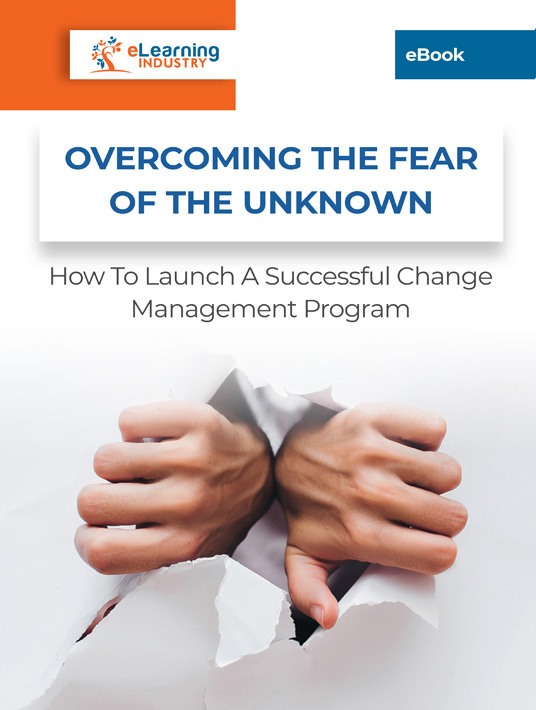7 Change Management Strategies To Engage Your Employees
Not being able to see the forest through the trees can be detrimental to your growing business. However, change management must be done at the individual level. Every employee is a piece of the puzzle. You need to win them over emotionally and mentally to achieve success on your own terms, instead of simply seeing the broader picture, which is to expand your SMB and its bottom line. Which employee-centered strategies should you implement in your online training program, especially if you’re a small business with an even smaller budget? Here are 7 organizational change management strategies to engage and inspire your staffers.

1. Personal Anecdotes That Demystify The Transition
There might be an air of mystery surrounding the change. Employees are unsure of the job security or of how their roles will adapt based on the organizational reshuffle. Personal anecdotes demystify the process and desired outcomes. They show staffers that there’s nothing to be afraid of and they humanize change management online training. For example, their manager shares a story about how they dealt with new protocols or leadership changes in the past. It also features tips to help employee training participants get through the rough spots and deal with negative mindsets or limiting beliefs.
2. Webinars To Introduce New Team Leaders
There’s always that uneasy period when new leaders come into the organization and bring their new way of thinking with them. Maybe they don’t follow the same guidelines as their predecessors. Or they want to shake things up in regard to task protocols or team dynamics. Host a live event where new managers can meet their department and slowly but surely ingratiate themselves. Employees ask questions and get to know their new department heads or CEOs. It gives everyone the chance to ease tension and figure out how to proceed without internal flare-ups. For example, staffers now understand that their manager has a unique sense of humor so that they don’t take offense. Just as the manager becomes aware of the team’s limits and personalities.
3. Social Media Groups That Fuel Meaningful Discourse
Launch a social media group to prep employees for the change and give them a platform to voice their opinions. It’s free and most (if not all) of your staffers' frequent social media daily—if not hourly. Make sure you set some rules to keep the discourse on track. You may even need a moderator to post prompts or questions that spark meaningful discussions. This should not be a place to air all their personal grievances, but to interact with online training developers and management during the change management process.
4. Fact Versus Fiction eLearning Infographics
There may be some doubts left over from the personal anecdotes or still some mystery surrounding the process. So, create fact versus fiction eLearning infographics to put the rumors to rest. Gossip is bound to spread around the organization the second the employees learn about the change. eLearning infographics differentiate the truth from the myth so that there aren’t any surprises. Everyone knows what's in store and how the transition will impact their job duties or departments. eLearning infographics are also ideal for task updates, team leadership style guides, and compliance reminders.
5. Immersive Simulations
Sometimes employees simply need to live through the transformation to see their worries eliminated. Immersive simulations allow them to experience all the setbacks, triumphs, and nuances of change management strategies, such as how to perform the new task or adhere to new compliance regulations. Employee training participants also learn from their mistakes and identify gaps they never had the opportunity to explore. Your SMB expansion comes with its fair share of challenges. However, it also tests the employees’ limits and reveals hidden talents because that’s all part of the professional growth.
6. Policy Demo Videos
Policies are just words that employees must memorize unless you show them how to apply them in real-world settings. Develop policy demo videos that teach them how to follow the rules and improve task performance. As well as identify steps they’ve missed or incorrect behaviors/habits. For instance, the new policy involves a different dress code they must immediately adhere to. So, show them the proper attire and offer tips to bring their wardrobe into compliance. Explain what happens if they break the rules and the importance of sticking to company guidelines. Include resource links to expand their understanding. Such as tutorials and serious games that reinforce the dress code policy and allow them to test out different looks.
7. Microlearning Guides
JIT support is an essential part of organizational change management strategies for SMBs. Create a microlearning guide for the most crucial aspects of business transformation. For example, a brief guide to highlight the new return process for your customer service team. Walk them through every step and help them avoid the most common mistakes. Remind them of the key policies and how the new process differs from the old, why it is better and how they can adjust their approach to lower the learning curve. Make it quick, convenient, and mobile-friendly so that employees get the memory refreshers and reinforcement they need on the go.
A common misconception about SMBs is that their potential for growth is capped by their budget and staff size. However, even the smallest businesses can reach a global market with the right frame of mind and an employee-centered change management online training program, of course. These assets make the transition personal and relatable so that staffers understand the reason behind the change, why your organization is expanding, even if it leads to growing pains, and how they can help you achieve success with their talents, experience, and emotional buy-in.
Every organization must endure change from time to time, and this can be frightening. Download the eBook Overcoming The Fear Of The Unknown: How To Launch A Successful Change Management Program to discover how to launch a change management program that is destined to be a roaring success.

